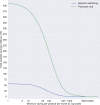New mechanism to identify cost savings in English NHS prescribing: minimising 'price per unit', a cross-sectional study
- PMID: 29439078
- PMCID: PMC5829890
- DOI: 10.1136/bmjopen-2017-019643
New mechanism to identify cost savings in English NHS prescribing: minimising 'price per unit', a cross-sectional study
Abstract
Background: Minimising prescription costs while maintaining quality is a core element of delivering high-value healthcare. There are various strategies to achieve savings, but almost no research to date on determining the most effective approach. We describe a new method of identifying potential savings due to large national variations in drug cost, including variation in generic drug cost, and compare these with potential savings from an established method (generic prescribing).
Methods: We used English National Health Service (NHS) Digital prescribing data, from October 2015 to September 2016. Potential cost savings were calculated by determining the price per unit (eg, pill, millilitre) for each drug and dose within each general practice. This was compared against the same cost for the practice at the lowest cost decile to determine achievable savings. We compared these price-per-unit savings to the savings possible from generic switching and determined the chemicals with the highest savings nationally. A senior pharmacist manually assessed whether a random sample of savings were practically achievable.
Results: We identified a theoretical maximum of £410 million of savings over 12 months. £273 million of these savings were for individual prescribing changes worth over £50 per practice per month (mean annual saving £33 433 per practice); this compares favourably with generic switching, where only £35 million of achievable savings were identified. The biggest savings nationally were on glucose blood testing reagents (£12 million), fluticasone propionate (£9 million) and venlafaxine (£8 million). Approximately half of all savings were deemed practically achievable.
Discussion: We have developed a new method to identify and enable large potential cost savings within NHS community prescribing. Given the current pressures on the NHS, it is vital that these potential savings are realised. Our tool enabling doctors to achieve these savings is now launched in pilot form at OpenPrescribing.net. However, savings could potentially be achieved more simply through national policy change.
Keywords: cost saving; openprescribing; prescribing.
© Article author(s) (or their employer(s) unless otherwise stated in the text of the article) 2018. All rights reserved. No commercial use is permitted unless otherwise expressly granted.
Conflict of interest statement
Competing interests: BG has received research funding from the Laura and John Arnold Foundation, the Wellcome Trust, the NHS National Institute for Health Research, the Health Foundation and WHO; he also receives personal income from speaking and writing for lay audiences on the misuse of science. AJW, HJC, SB, RC and LF are employed on BG’s grant from the Health Foundation. RC reports personal fees as a paid member of an advisory board from Galen Pharmaceuticals, Martindale Pharma, Galderma (UK), ProStraken Group PLC, Menarini Farmaceutica Internazionale SRL, Stirling Anglian Pharmaceuticals , outside the submitted work; and RC is employed by a CCG to optimise prescribing.
Figures
References
-
- NHS Digital. Prescriptions Dispensed in the Community, Statistics for England - 2005-2015. 2016. http://content.digital.nhs.uk/catalogue/PUB20664 (accessed 24 May 2017).
-
- Alderwick H, Robertson R, Appleby J, et al. . Better Value in the NHS: the role of changes in clinical practice. London, UK: The King’s Fund, 2015.
Publication types
MeSH terms
Substances
Grants and funding
LinkOut - more resources
Full Text Sources
Other Literature Sources
Molecular Biology Databases

